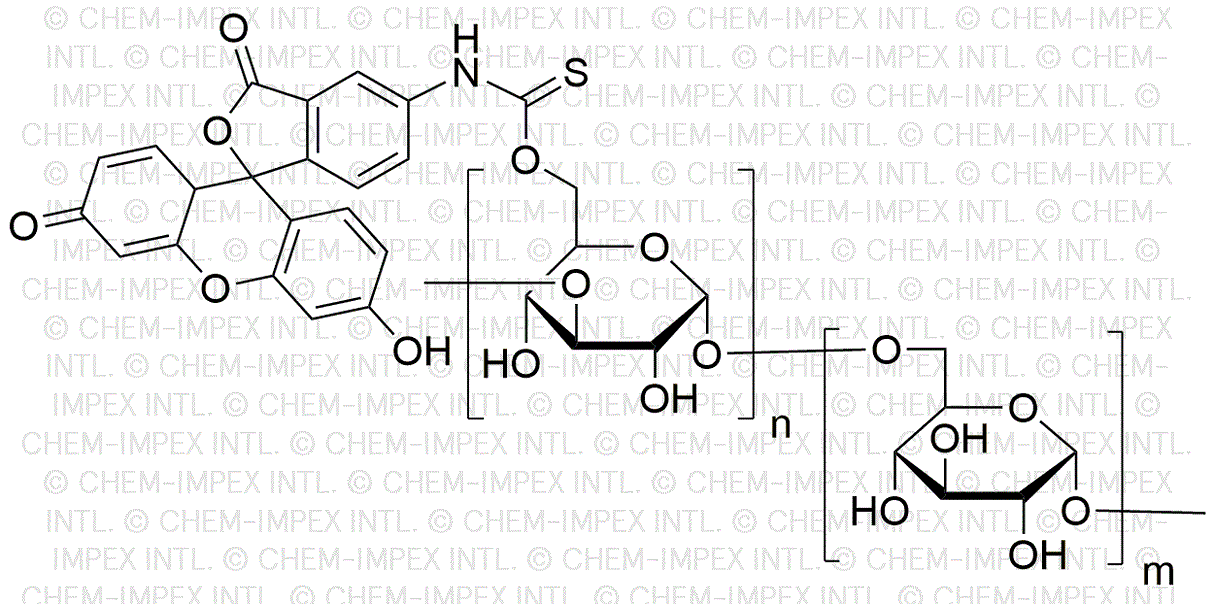Fluorescein isothiocyanate–dextran average mol wt 10,000 is widely utilized in research focused on:
- Cell Tracking: This compound is commonly used in cellular biology to label and track cells in vivo, allowing researchers to visualize cell migration and behavior in real-time.
- Fluorescence Microscopy: It serves as a fluorescent marker in microscopy, enhancing the visibility of cellular structures and processes, which is crucial for detailed imaging studies.
- Drug Delivery Studies: In pharmaceutical research, it helps in evaluating the efficacy of drug delivery systems by tracking the distribution of therapeutic agents within biological tissues.
- Immunohistochemistry: This compound is employed in staining tissues to identify specific proteins, aiding in the diagnosis of diseases and the understanding of pathological processes.
- Vascular Studies: It is used to study blood flow and vascular permeability, providing insights into cardiovascular health and disease mechanisms.
Información general
Propiedades
Seguridad y normativas
Aplicaciones
Fluorescein isothiocyanate–dextran average mol wt 10,000 is widely utilized in research focused on:
- Cell Tracking: This compound is commonly used in cellular biology to label and track cells in vivo, allowing researchers to visualize cell migration and behavior in real-time.
- Fluorescence Microscopy: It serves as a fluorescent marker in microscopy, enhancing the visibility of cellular structures and processes, which is crucial for detailed imaging studies.
- Drug Delivery Studies: In pharmaceutical research, it helps in evaluating the efficacy of drug delivery systems by tracking the distribution of therapeutic agents within biological tissues.
- Immunohistochemistry: This compound is employed in staining tissues to identify specific proteins, aiding in the diagnosis of diseases and the understanding of pathological processes.
- Vascular Studies: It is used to study blood flow and vascular permeability, providing insights into cardiovascular health and disease mechanisms.
Documentos
Hojas de datos de seguridad (HDS)
La SDS proporciona información de seguridad completa sobre la manipulación, el almacenamiento y la eliminación del producto.
Especificación del producto (PS)
La PS proporciona un desglose completo de las propiedades del producto, incluida la composición química, el estado físico, la pureza y los requisitos de almacenamiento. También detalla los rangos de calidad aceptables y las aplicaciones previstas del producto.
Certificados de análisis (COA)
Busque certificados de análisis (COA) ingresando el número de lote del producto. Los números de lote y de partida se pueden encontrar en la etiqueta de un producto después de las palabras "Lote" o "Lote".
Número de catálogo
Número de lote/lote
Certificados de origen (COO)
Este certificado de origen confirma el país en el que se fabricó el producto y también detalla los materiales y componentes utilizados en él y si se deriva de fuentes naturales, sintéticas u otras fuentes específicas. Este certificado puede ser necesario para cumplir con las normativas aduaneras, comerciales y regulatorias.
Número de catálogo
Número de lote/lote
Hojas de datos de seguridad (HDS)
La SDS proporciona información de seguridad completa sobre la manipulación, el almacenamiento y la eliminación del producto.
DownloadEspecificación del producto (PS)
La PS proporciona un desglose completo de las propiedades del producto, incluida la composición química, el estado físico, la pureza y los requisitos de almacenamiento. También detalla los rangos de calidad aceptables y las aplicaciones previstas del producto.
DownloadCertificados de análisis (COA)
Busque certificados de análisis (COA) ingresando el número de lote del producto. Los números de lote y de partida se pueden encontrar en la etiqueta de un producto después de las palabras "Lote" o "Lote".
Número de catálogo
Número de lote/lote
Certificados de origen (COO)
Este certificado de origen confirma el país en el que se fabricó el producto y también detalla los materiales y componentes utilizados en él y si se deriva de fuentes naturales, sintéticas u otras fuentes específicas. Este certificado puede ser necesario para cumplir con las normativas aduaneras, comerciales y regulatorias.


